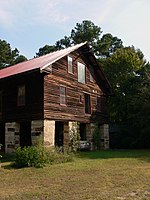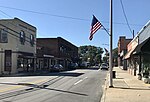Walnut Hill Historic District (Knightdale, North Carolina)

The Walnut Hill Historic District is a collection of 40 family dwellings, agricultural outbuildings, and other structures and sites associated with the Walnut Hill Plantation and the Mial-Williamson and Joseph Blake farms near Shotwell, North Carolina. The historic district represents the post-Civil War growth of one of the largest agricultural centers in Wake County. It is situated primarily along the northeast end of Mial Plantation Road (State Road 2509) between its intersections with Major Slade and Smithfield Roads.The Walnut Hill Historic District was listed on the National Register of Historic Places in October 2000. The nearby Walnut Hill Cotton Gin and Oaky Grove Plantation have been listed in the National Register separately, in 1986 and 1993, respectively.
Excerpt from the Wikipedia article Walnut Hill Historic District (Knightdale, North Carolina) (License: CC BY-SA 3.0, Authors, Images).Walnut Hill Historic District (Knightdale, North Carolina)
Mial Plantation Road,
Geographical coordinates (GPS) Address Nearby Places Show on map
Geographical coordinates (GPS)
| Latitude | Longitude |
|---|---|
| N 35.733888888889 ° | E -78.445555555556 ° |
Address
Mial Plantation Road
Mial Plantation Road
27610
North Carolina, United States
Open on Google Maps




